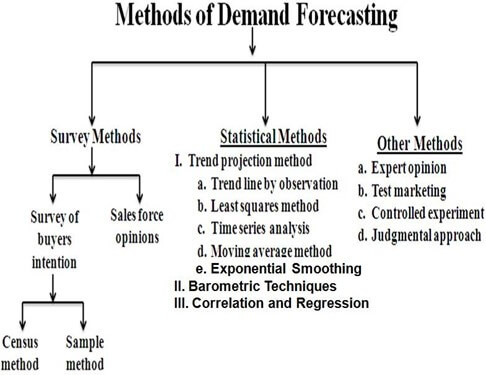Methods Of Forecasting
Several methods are employed for forecasting demand. All these methods can be grouped under survey method, statistical method and other methods. Survey methods and statistical methods are further subdivided in to different categories.

I. Survey Method
A. Survey of Buyers Intention:
To anticipate what buyers are likely to do under a given set of circumstances, a most useful source of information would be the buyers themselves. It is better to draw a list of potential buyers. Approach each buyer to ask how much does he plans to buy of the given product at a given point of time under particular conditions
1. Census Method: Surveying all buyers, which is comprehensive but time-consuming and costly.
2. Sample Method: Surveying a representative group of buyers, which is faster and more cost-effective. Normally involves using questionnaires.
B. Sales Force Opinions:
Salespeople provide insights into buyer behavior based on their interactions, utilizing quick methods like telephone, fax, or video-conferences.
II. Statistical Methods
A. Trend Projection Methods:
1. Trend Line by Observation: Estimating trends by plotting actual sales data and projecting future trends based on visual observation.
2. Least Squares Method:
Statistical formulas are used to determine the trend line that best fits the data, assuming a proportional change in sales over time. The linear trend equation is: S = x + y(T), where S is sales, T is the year number, x and y are calculated from past data.
Equations:
ΣS = Nx + yΣT
ΣST = xΣT + yΣT2
Where N is the number of years.
3. Time Series Analysis:
Forecasting future values based on historical data collected at successive intervals of time. Time series include components like Secular trend (long-term), Seasonal trend, Cyclical trend (business cycle), and Irregular trend (random variations).
4. Moving Average Method:
Y = T + S + C + I
Where Y is future sales, T is Secular trend, S is Seasonal trend, C is Cyclical trend, and I is Irregular trend. This method computes averages of past events to predict future events, with the average adjusting based on the number of years selected.
5. Exponential Smoothing:
The most popular technique for short-run forecasts, giving higher weights to recent values and lower weights to distant past values. Formula:
Formula goes here…

C. Barometric Techniques:
Barometric techniques use one set of data to predict another set, such as using a relevant indicator (barometer) to forecast demand for a product or service. For example, demand for cable TV might be linked to the number of new houses occupied in a given area.
D. Correlation and Regression Method:
Correlation and regression are statistical techniques to measure the degree of association between two variables, like sales and advertisement expenditure. A correlation coefficient measures the extent of correlation: +1 for perfect positive correlation, -1 for perfect negative correlation, and 0 for no correlation.
In regression analysis, an equation is estimated to best fit the observations of dependent and independent variables. The equation Y = a + bX forecasts the dependent variable (Y) based on the independent variable (X).
Equations:
ΣY = Na + bΣX
ΣXY = aΣX + bΣX2
III. Other Methods
a) Experts Opinion:
Experts are well-informed individuals who provide valuable insights without vested interests. Their opinions serve as an additional source of information for forecasting demand.
b) Test Marketing:
Manufacturers often conduct test marketing in a limited market to gauge consumer reactions before a full-scale product launch. This helps in refining the product and predicting sales in new markets or distribution channels.
c) Controlled Experiments:
In controlled experiments, major factors influencing demand are manipulated to suit different customer segments. This method helps in identifying the most appealing product configurations or pricing strategies within targeted markets.
d) Judgment Approach:
When none of the above methods directly apply, management relies on its own judgment to forecast demand based on experience and qualitative assessments.
